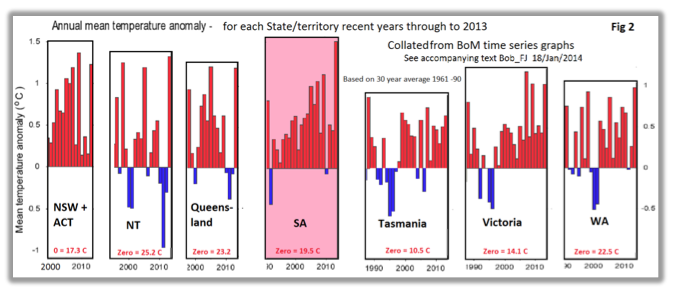I HAVE already detailed my concerns with the claim by the Bureau of Meteorology that 2013 was the hottest year on record. Thank you for your many comments in the threads that followed the two blog posts. I am taking many of these comments into consideration in the development of a further set of questions.
In the meantime Bob Fernley-Jones, a retired engineer based in Melbourne, suggests that even if one accepts the truncating and adjusting that the Bureau has undertaken to arrive at the 2013 record annaul average temperature, given the actual temperature statistics published by the Bureau, David Jones was not justified in making the headline-grabbing statements that he did on January 3, in particular that there is a general warming trend and that it is Australia-wide.
Mr Fernley-Jones makes the following points, with the charts and supporting references available for download here:
1. One data point does not make a trend. There has been considerable variability over recent years in both the annual mean temperature anomaly and also the annual maximum temperature anomaly, Chart 1.
2. When regional variability is considered it is evident that only one state, South Australia, was signficiantly warmer in 2013, Chart 2.
3. The seasonal distribution of temperature is important, for instance warmer winters might arguably be a good thing for South Australia, while hotter summer are generally not. When the season mean temperatures for South Australia are considered for the period 1990 to 2013, the summer of 2013 was not particularly hot, Chart 3. In fact not a single season was hotter in 2013.
4. While much has been made of January 2013 being exceptionally hot, when the mean January temperature anomaly is plotted for South Australia back to 1910, Chart 4, it is apparent that 2013 was not an exceptionally hot January with hotter January’ occuring in the 1930s.
5. According the Bureau’s own time series data based on truncated and adjusted data series, mean January maximum temperatures have been flat since 1934 for the Northern Territory, and since 1947 for Queensland. New South Wales and the Australian Capital Territory have hotter January’s going back to 1938. South Australia, the hottest region for 2013, has eight hotter January’s going back to 1933. Tasmania has about 25 hotter January’s going back to 1917. Victoria has about 20 hotter January’s going back to 1939.
Mr Fernley-Jones’ critic can be read in more detail by downloading this document BobF-J_BlogVer2.



 Jennifer Marohasy BSc PhD has worked in industry and government. She is currently researching a novel technique for long-range weather forecasting funded by the B. Macfie Family Foundation.
Jennifer Marohasy BSc PhD has worked in industry and government. She is currently researching a novel technique for long-range weather forecasting funded by the B. Macfie Family Foundation.